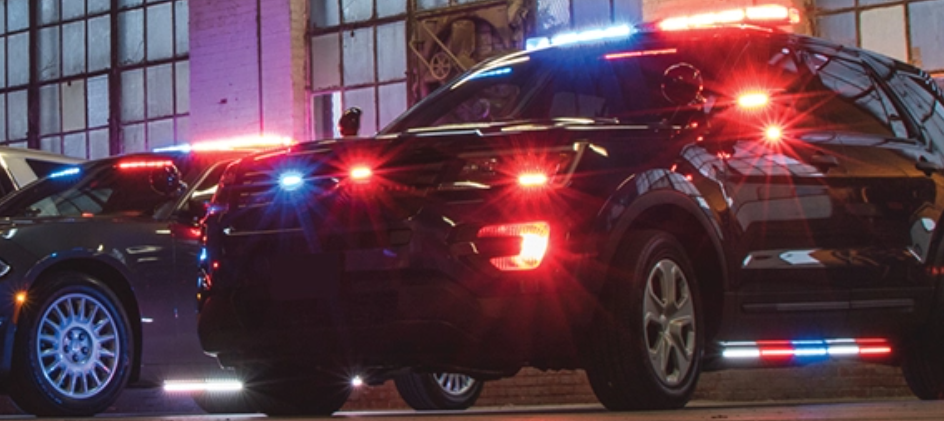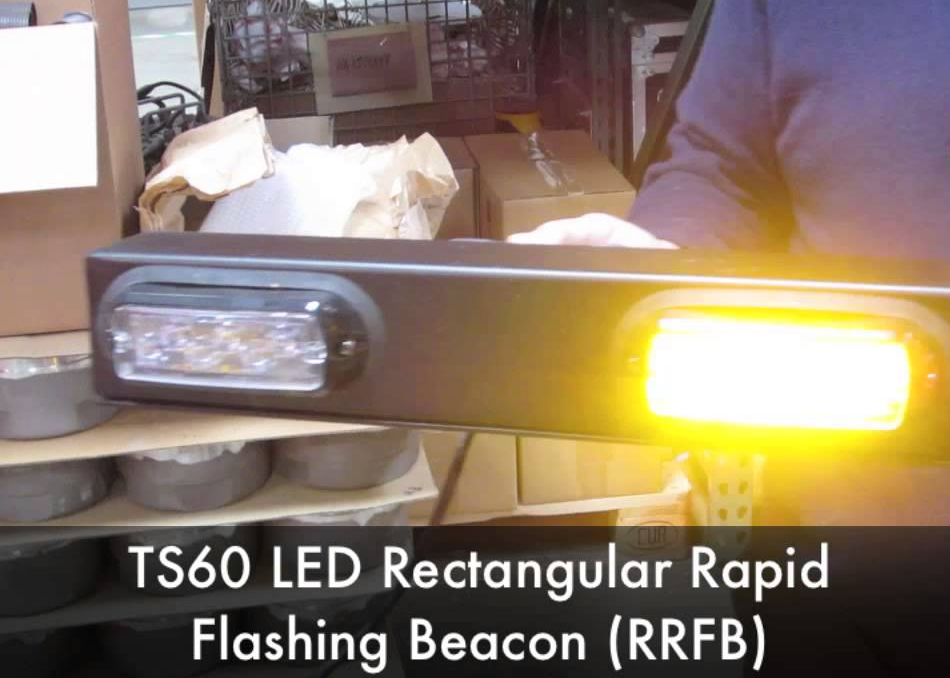LED flashing lights are entirely unregulated. There is no limit to how intense they can be or how rapidly they flash. This lack of regulation has lead to epileptic seizures, migraines, panic attacks, eye damage, decreased vision and increased risk of injury and death.
Example of Safe Flashing Lights
Examples of Dangerous LED Flashing Lights
WARNING: SEIZURE TRIGGERS!
The manufacturers of these LED Flashing lights admit that they cause momentary blindness and/or eye damage, as shown in this warning label from Whelen Engineering.

A company called Fleet Safety proudly displays these eye-damaging devices on their website.

Rectangular Rapid Flashing Beacons
RRFBs direct high-intensity, rapidly flashing light directly into the eyes of drivers, forcing them to stop through fear, intimidation, and loss of vision. The design of these devices is inherently unsafe, placing public health and safety in jeopardy.

In the marketing video below, the narrator says “attention grabbing strobe lights” at the 0:20 mark. The fact that the manufacturer admits that the RRFB is a strobe light is significant, since the Federal Highway Administration has not authorized strobe lights for flashing beacons. Additionally, the narrator claims that the RRFB has significantly more surface and is brighter and more eye catching, all dangerous actions. The narrator claims “easy installation”, which also implies easy removal, which would eliminate any contention by a city that removal of an RRFB is a cost burden.
The RRFB was initially given interim approval by the FHWA, then that that approval was revoked due a patent issue. Once the patent issue was resolved, the FHWA again authorized interim approval, requiring each state to request individual approval from the FHWA.
https://mutcd.fhwa.dot.gov/resources/interim_approval/ia21/index.htm – RRFB Interim approval.
https://mutcd.fhwa.dot.gov/resources/interim_approval/ia21/faq/index.htm – RRFB interim approval.
The Manual of Uniform Traffic Control Devices is the standard for highway signs and is maintained by the Federal Highway Administration. Many states have their own state version of this same document with slight modifications particular to the state.
Manual of Uniform Traffic Control Devices – This is a link to the current version, 2009.
Chapter 4L – Flashing Beacons –
Quote: “Beacons shall be flashed at a rate of not less than 50 or more than 60 times per minute. The illuminated period of each flash shall be a minimum of 1/2 and a maximum of 2/3 of the total cycle.” – RRFBs flash much faster than once per second. Therefore, RRFBs do not comply with the MUTCD.
Quote: “The advance warning area may vary from a single sign or high-intensity rotating, flashing, oscillating, or strobe lights on a vehicle to a series of signs in advance of the TTC zone activity area.” – The MUTCD does not define the difference between a flashing light or strobe light. However, since RRFB means Rectangular Rapid Flashing Beacon, we would understand that RRFBs must comply with section 4L, Flashing Beacons. The marketing video for the RRFBs states that they are “attention grabbing strobe lights”, so the manufacturer seems to consider the RRFB to be a strobe light, which is not an approved device.
Effects of Yellow Rectangular Rapid-Flashing Beacons on Yielding at Multilane Uncontrolled Crosswalks. – 2010 study by FHWA – An early study of RRFBs by the FHWA
Evaluation of Pedestrian Hybrid Beacons and Rapid Flashing Beacons – 2016 Texas A&M Study. The study invalidly uses candela to measure optical power. For surface sources such as LED, the correct metric is candela per square meter. There is no discussion of cd/m2 which is the brightness and power metric for surface source emitters.
On March 6, 2022, the Soft Lights Foundation requested termination of the interim approval of RRFBs because they are dangerous and discriminatory. – Letter to FHWA – In our letter, we noted that the researcher used data for point sources, rather than the correct data for surface source LEDs. The research on RRFBs is thus invalid.
The Soft Lights Foundation was sent this letter detailing the injury caused by RRFBs.

Strobe Lights
There is no definitive agreement on the definition of strobe light. However, in general, the definion of strobe light is similar to the one found in the Britannica dictionary. “A bright light the flashes on and off very quickly.” – https://www.britannica.com/dictionary/strobe-light
LED flashing lights are intense, directed energy beams that flash on and off in a digital manner. Companies such as Carmanah claim that their RRFBs are strobe lights. Police reports and discussion groups refer to LED flashing lights as strobe lights. Therefore, there is little doubt that LED flashing lights are strobe lights and not simply flashing lights.
Assault
Below are legal definitions of assault. RRFBs are obviously designed to instill fear and apprehension into drivers. That’s why the light is so intense and flashing so rapidly. This constitutes assault.
“The definition of assault varies by jurisdiction, but is generally defined as intentionally putting another person in reasonable apprehension of an imminent harmful or offensive contact. Physical injury is not required.” – https://www.law.cornell.edu/wex/assault
“Assault is often defined as any intentional act that causes another person to fear an attack or imminent physical harm. This definition recognizes that placing another person in fear of bodily harm is itself an act deserving of punishment, even if the victim of the assault is not physically harmed.” – https://www.nolo.com/legal-encyclopedia/assault-battery-aggravated-assault-33775.html
“An intentional act by one person that creates an apprehension in another of an imminent harmful or offensive contact.” – https://legal-dictionary.thefreedictionary.com/assault
Suing a City
Ohio – Cities are generally immune for liability, but there are exceptions. “If someone’s injuries result from physical defects that occur due to negligence within or on the grounds of buildings that are used for governmental functions, or due to the negligent failure to repair or remove obstructions on a public road, then a city may be liable.” – https://www.ohiobar.org/public-resources/commonly-asked-law-questions-results/personal-injury/when-can-a-city-be-sued-for-personal-injury/
Iowa – “Every municipality is subject to liability for its torts and those of its officers and employees, acting within the scope of their employment or duties, whether arising out of a governmental or proprietary function.” – https://www.legis.iowa.gov/docs/ico/chapter/670.pdf –
Minnesota – “Every municipality is subject to liability for its torts and those of its officers, employees and agents acting within the scope of their employment or duties whether arising out of a governmental or proprietary function.” – https://www.revisor.mn.gov/statutes/cite/466/full
Oregon – “Every public body is subject to civil action for its torts and those of its officers, employees and agents acting within the scope of their employment or duties, whether arising out of a governmental or proprietary function or while operating a motor vehicle in a ridesharing arrangement authorized under ORS 276.598 (Car or van pools).” – https://oregon.public.law/statutes/ors_30.265
Flashing Light Studies
2022 – To our knowledge, no studies have been performed to verify that rapidly flashing LED light is safe for those with epilepsy, autism, migraines, PTSD or other neurological sensitivities or that this light is safe for human eyes.
April 22, 2022 – Can behavioral interventions be too salient? Evidence from traffic safety messages. – Electronic signs are distracting and lead to more crashes.
February 7, 2022 – Visually sensitive seizures: An updated review by the Epilepsy Foundation – The abstract states that visually-induced seizures remain significant public health hazards so they warrant ongoing scientific and regulatory efforts and public education and that images with flashes brighter than 20 candelas/m2 at 3-60 (particularly 15-20) Hz occupying at least 10 to 25% of the visual field are a risk. This confirms that LED flashing lights will trigger epileptic seizures.
December, 2021 – Effects of Emergency Vehicle Lighting Characteristics on Driver Perception and Behavior – This study concludes that high intensity flashing lights put lives at risk.
January 28, 2021 – How Do Flashing Lights Trigger Epileptic Seizures? – This overview article mentions that contrast is a trigger, as is flash rate.
June 11, 2019 – Stroboscopic light effects during electronic dance music festivals and photosensitive epilepsy: a cohort study and case report The connection between strobe lights and seizures.
April 2, 2019 – Impacts of Flashing Emergency Lights This study concludes that strobing LED lights are dangerous.
January, 2018 – Police Warning Signals – This article in Police Chief Magazine discusses the dangers of overly intense strobing lights.
June 5, 2016 – Why Running Lights and Sirens is Dangerous – Flashing Lights and Sirens may save a few minutes, but does not change the outcome of the event. There is no value to using them, but there is harm.
June 1, 2016 – National Institutes of Health – Psychological Factors in Exceptional, Extreme and Torturous Environments This scientific research shows that strobing LED lights are instruments of torture.
2012 – Assessing the Photobiological Safety of LEDs – 2012 report by Underwriters Laboratories. – Basically, there are no eye safety regulations for LEDs.
October, 2010 – Ambulance Lights – Article on ambulance lights. “Fewer lights, flashing slower & less brightly are more effective.”
August 5, 2001 – Rear Lighting Configurations for Winter Maintenance Vehicles Strobing lights are less effective than static lights for safety.
December 27, 1955 – Siren, Light Removal Makes Police Unhappy – “Removal of the sirens and red lights has materially reduced accidents involving police cars rushing to other smashups or speeding to the scene of a crime.”